Book contents
- Frontmatter
- Contents
- List of figures
- List of tables
- Notes on contributors
- Preface
- The club framework
- 1 Voluntary regulation of NGOs and nonprofits: an introduction to the club framework
- Part I Club emergence
- Part II Club sponsorship and club design
- Part III Club design and effectiveness
- Future research and conclusions
- Index
- References
1 - Voluntary regulation of NGOs and nonprofits: an introduction to the club framework
from The club framework
Published online by Cambridge University Press: 10 November 2010
- Frontmatter
- Contents
- List of figures
- List of tables
- Notes on contributors
- Preface
- The club framework
- 1 Voluntary regulation of NGOs and nonprofits: an introduction to the club framework
- Part I Club emergence
- Part II Club sponsorship and club design
- Part III Club design and effectiveness
- Future research and conclusions
- Index
- References
Summary
The global nonprofit and nongovernmental (NGO) sector has expanded substantially during the past two decades. As a result of this “global associational revolution” – marked by massive infusion of funds from governments, international organizations, foundations, and individuals – the nonprofit sector became a major component of the social service delivery system in most countries (Salamon et al., 2003; Salamon, 1994). This growth also thrust nonprofits and NGOs into the middle of contemporary policy debates over the appropriate role for governments and markets in the provision of public services (Giddens, 1998; Anheier and Salamon, 2006). With this expansion, the nonprofit sector also became a target for increased scrutiny, in part because it appeared to attract “bad apples” along with well-intentioned, principled organizations. Scandals and charges of nonprofit mismanagement and misappropriation have been extensively covered by the media (Fremont-Smith and Kosaras, 2003; Gibelman and Gelman, 2004; Greenlee et al., 2007). As a result, nonprofits face growing demands for accountability from resource providers as well as from the constituents they claim to serve (Edward and Hulme, 1996; Spiro, 2002; Brody, 2002; Ebrahim, 2003).
While scandals tend to impose costs on the specific wrongdoers, they can muddy the reputation of all actors with similar sectoral scope or organizational characteristics. Indeed, high-profile cases of governance failure have tended to impose negative reputational externalities on all nonprofits. A recent global opinion survey found that in a number of countries worldwide, the nonprofit sector is now less trusted than government or business (Edelman Trust, 2007).
- Type
- Chapter
- Information
- Voluntary Regulation of NGOs and NonprofitsAn Accountability Club Framework, pp. 3 - 38Publisher: Cambridge University PressPrint publication year: 2010
References
- 14
- Cited by



